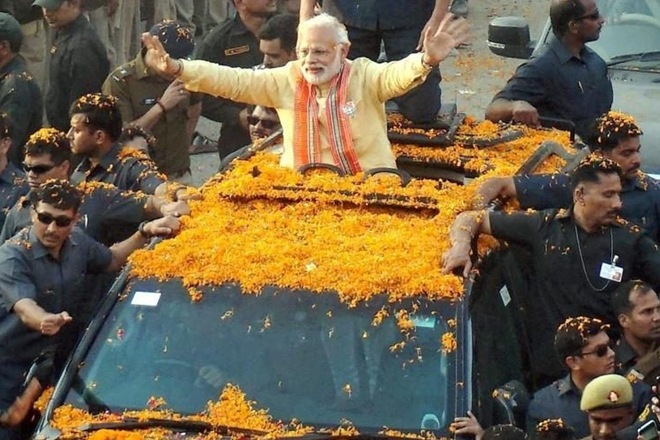The Bharatiya Janata Party’s (BJP) recent debacle in three Hindi heartland states of Rajasthan, Madhya Pradesh and Chhattisgarh came as a surprise to many with Congress and other non-NDA parties trying to pin the defeat on Prime Minister Narendra Modi. The results fueled talks of giving a final shape to the proposed grand alliance under the leadership of Congress president Rahul Gandhi. But more than the opposition, it is the internal war brewing within the BJP that appears to have troubled Modi more.
Soon after the declaration of results, talks of Nitin Gadkari as a possible replacement to Modi as prime ministerial candidate started to gain momentum. Gadkari, an RSS man, is said to have the support of Mohan Bhagwat. He has also openly spoken against the failure of the leadership in taking the responsibility for the party’s continuous loss in the year. Despite his repeated denial to any such move, the buzz around his name was believed to be the RSS’ message to Modi.
Some other top functionaries too voiced their dissent, but not openly. Newspaper reports had it that senior BJP leaders wanted Modi and party chief Amit Shah to own up for the defeat in the states just as they claimed credit for the party’s victories post 2014. The RSS, the ideological mentor of the BJP, has been mounting pressure of the BJP over a host of other issues too. The vociferous campaign for Ram Mandir by RSS and other right-wing outfits have also put Modi on the back foot. While any concerted move that could see a change in leadership at the BJP helm is still a long shot, it has certtainly come as an embarrassment to the BJP.
Going into the 2019 Lok Sabha polls though, Modi still remains the topmost contender for the prime ministerial post. His popularity stands undisputed despite the string of defeats for the party in states. In fact, experts believe that it was the Modi factor that enabled the BJP to put up a strong performance in states where a loss was a foregone conclusion.
While in Rajasthan, several agencies had predicted a poor show by the BJP, the saffron party performed certainly well giving a tough fight to the Congress. The difference of voting percentage between the two parties was just 0.5%. In Madhya Pradesh, the scene was no different where the party pocketed 0.1% votes more than the Congress but failed to cross the halfway mark. However, in Chhattisgarh, the outcome was really shocking for the BJP which was expecting the fourth consecutive term for Raman Singh. The party won just 16 out of 90 seats.
The outcome of assembly elections gave an opportunity to the Congress to project its president Rahul Gandhi as the leader of the proposed grand alliance comprising the opposition parties. But the way party performed in Rajasthan and Madhya Pradesh where the fight went down to the wires gave hope to the BJP that it will bounce back in 2019 when parliamentary elections will be held to elect a new government.
The 2019 elections, which many have seen as a test of popularity of Modi as well as Rahul, Modi clearly has an edge. He has wider acceptance than Rahul. While Modi will be the NDA’s obvious choice, a consensus still eludes the opposition in projecting Rahul Gandhi as its leader. The Congress is making desperate attempts to give final shape to forge an alliance of non-NDA parties under his leadership. Several key leaders including Mamata Banerjee of TMC, Mayawati of BSP and Akhilesh Yadav of SP have already spoken against accepting Rahul Gandhi as their leader. In Uttar Pradesh, the state with the largest number of Lok Sabha seats (80), the SP an BSP have reached an agreement of contesting the elections together and have offered only two seats to the Congress in Uttar Pradesh.
Meanwhile, several surveys have predicted that Modi is set to get another term in 2019. Although tough decisions like demonetisation, GST and fuel price hike have dented his image, the BJP leader is far ahead of Rahul Gandhi in terms of popularity. According to ABP News and C-Voter survey, the BJP is likely to get around 291 seats in 2019 if BSP and SP come together in Uttar Pradesh where the BJP had won 73 seats in 2014.
The Congress also knows that although it managed to form governments in Rajasthan and Madhya Pradesh with support from SP and BSP, winning their support in 2019 won’t be an easy task. Moreover, the Congress knows it is no longer the party it used to be pre-2014. The poll drubbing at the hands of Modi reduced it to 44 seats, its lowest ever, and the successive losses in state elections relegated it to the sidelines, making it dependent on string regional parties to keep itself significant.
Come 2019 and Modi will enter the election campaign with all his might. It was under his leadership that BJP went on to form a government on its own for the first time ever. With Modi’s personal popularity and prestige under test, there is little doubt that he will come out roaring. Underestimating Modi’s political prowess and his ability to strike a chord with the masses will be foolish to say the least.

